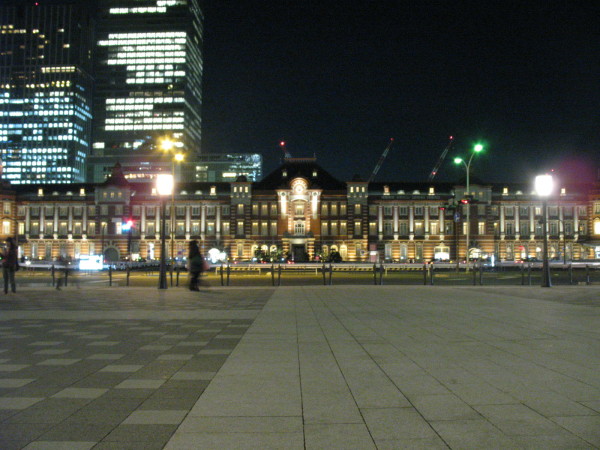
This post is continued from Trip to Tohoku and Nagano in 2013 winter – Part 1, from Narita airport to Ueno.
After I stored my suitcase in the coin operated locker, I walked around Tokyo station. First of all, I wanted to see Tokyo station Marunouchi side. The above picture is exactly I wanted to see. This heritage building had been completed to restore in last October. A part of this building was open as high-end hotel, Tokyo Station Hotel.


Marunouchi side used to be office area. But now several Marunouchi buildings have lots of shops and restaurants. When you go to Imperial Palace, you can access there from Marunouchi side. You may drop by this area.

Then I moved to another side, Yaesu exit.
Whenever I get on a train at Tokyo station, I drop by one of major department store, Daimaru (大丸) department store to grab some foods. Daimaru is one of major department stores in Japan.

Before you get on the train, you can get some foods in the station and even at the platform. Some trains have on-board sales. But most of delicatessens are owned by high-end restaurant, hotels and specialized shops, such as Japanese sweets, fresh seafood and local meat. So basically foods are much more tasty and price is not so expensive.



Of course you can finish to eat before boarding. But I want to eat and drink on board. Even though I don’t know why, taste is much better when I ate in the train. If you agree with me, shop some foods at department store may be one of your choice.
If you need other information about Tokyo station, such as transfer, platform and trucks information, please check the post, Tokyo station guide. How to change the trains, Shinkansen, Narita Express and other local trains.
Continue to Trip to Tohoku and Nagano in 2013 winter – Part 3, from Ueno to Akita by Akebono.




Comments
There are too many fried goodies at stations to take on board. One chain that sells katsu based things has this delicious one filled with three types of cheese. After trying it at Okayama, I was unable to resist in Osaka, Sendai and Morioka. It was one of the most amazing (and undoubtedly fattening) things I’ve ever eaten 🙂
Unfortunately, in my home of Brisbane we don’t have train goodies, and you can’t eat on local services 🙁 . We only have a couple of trains I would classify as limited express, and we also have a few overnight services that you can really take in the rail experience on.
Best regards,
Jonathan Ayre
Hi Jonathan,
I think Japan is very special in the world. Every single towns and villages have their own local food.
Cheers,
Takeshi / JP Rail
Hi Takeshi,
I think Japan has that special quality too. Having such a strong rail culture helps. My home state of Queensland also has 1,067mm gauge like Japan so there is often interchange of technology. Our top EMU, “tilt train” is actually based on the JR Shikoku 8000 series but can operate at up to 210kph on the Queensland Main Line, but poor track quality only means it can be done in small areas. Australia is currently debating High-Speed Rail technology, including Shinkansen. I hope that in time my country can enjoy the benefits of rail culture more 🙂
Best regards,
Jonathan Ayre
Hi Jonathan,
I don’t know in Brisbane, but we’ve got several steam trains running on weekends here in Sydney. I was very impressed when I saw triple headers of steam engines. I’ve only seen up to double headers in Japan.
Hi Takuji,
Queensland Rail runs monthly public steam train trips with rollingstock from as early as 1909 with minimal retrofitting inside, but we don’t use double or triple headers often. Our locos that climb the Great Dividing Range are double-headed because of the gradient, but we don’t pull long trains or have steep mountains very often. There are also private trips that lease steam locos for longer trips, which have included Brisbane to Townsville (1300km) and further.
Interestingly, I noticed Ban’Etsu Monogatari had been retrofitted with Automatic Train Stop. It was good to get a look at the loco up close.
Best regards,
Jonathan Ayre
I agree – eating on the train is much more fun. It doesn’t matter which train, either. It’s just fun!
Hi Takeshi san,
I agree. Food from department store basement is cheaper and tastes better. The only problem for me is that there are so many choices, food looks good and I buy more than I can eat at the end…. that makes my luggage heavier! Thank you for sharing the story.
Hi Tak san,
Exactly. I always buy too much as well. 🙂
Cheers,
Takeshi / JP Rail